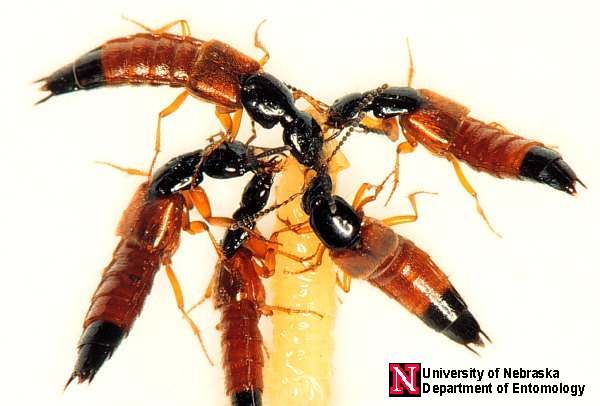Common Name: Staphylinid
Scientific name:
Aleochara bilineata
Coleoptera:Staphylinidae
Type
Rove beetle larvae are maggots and pupae parasites when they are about to pupate, but both adult and larva are generalist predators
Hosts
Both adults and larvae are predators of root maggots' eggs and larvae, mites, worms, nematodes, and other small insects. Adults tend to be cannibalistic, eating their own eggs and attacking other adults when food supply is low.
Description
Eggs are
tiny, about 0.5 mm long and 0.4 mm wide, pear-shaped, pale green in color, and are covered with a gelatin-like material. These are laid by female adults in the soil among the roots of the root-maggot infested plants. The eggs hatch 5-10 days later.
The first instar larvae are pale brown, about 1.5 mm long, slender, segmented, and tapered toward the anterior. They have large heads. The parasitic second and third instar larvae are white, have rudimentary legs, and are found within the host puparium.
Before pupating, a larva will actively search for a host (pupa of maggot) in the surrounding soil. It will pupate in the pupa of the maggot by entering into its cocoon and feeding its contents, and then pupate itself inside for about 3-4 weeks before emerging as an adult. It is possible that two or more larvae enter into one maggot pupa but only one will survive and mature.
Adult rove beetles are brown, reddish-brown, or black or have gray markings on the wings and
abdomen, with slender elongate bodies. Their wing covers are shorter than the abdomen where most part of the abdomen is exposed. Both adults and larvae have well-developed 'jaws' cross in front of the head. They live mostly in decaying organic matter but are also found in moist agricultural soils or in habitats where large numbers of fly larvae live. When disturbed, they run very fast, with their abdomen lifted upward, like that of scorpions. Adults are good fliers as well.
Conservation
Provide ground covers or mulches within and around fields for rove beetles love to stay in moist decaying organic matter; provide hiding sites and alternative habitats and plant flowering borders, hedges, and other perennial habitats as a source of food and shelter; and provide protection by not spraying broad spectrum pesticides.
External links
References
- CABI. (2000): Crop protection compendium. Global module, 2nd edition. CABI Publishing, Wallingford, UK.
- Yepsen, R. Editor. (1984): The encyclopedia of natural insect and disease control. Rodale Press, Emmaus, PA.

